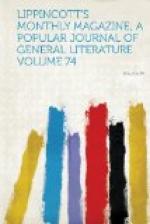Of all the emerald imitations that have descended to us from antiquity, none are more remarkable, none more interesting to the antiquary and historian, than the famous Sacro Catino of the cathedral of Genoa. This celebrated relic is a glass dish or patera fourteen inches in width, five inches in depth and of the richest transparent green color, though disfigured by several flaws. It was bestowed upon the republic of Genoa by the Crusaders after the capture of Caesarea in 1101, and was regarded as an equivalent for a large sum of money due from the Christian army. It was traditionally believed to have been presented to King Solomon by the queen of Sheba, and afterward preserved in the Temple, and some accounts relate that it was used by Christ at the institution of the Lord’s Supper. The Genoese received it with so much veneration and faith that twelve nobles were appointed to guard it, and it was exhibited but once a year, when a priest held it up in his hand to the view of the passing throng. The state in 1319, in a time of pressing need, pawned the holy relic for twelve hundred marks of gold (two hundred thousand dollars), and redeemed it with a promptness which proved its belief in the reality of the material as well as in its sanctity. And it is also related that the Jews, during a period of fifty years, lent the republic four million francs, holding the sacred relic as a pledge of security. Seven hundred years passed away, when Napoleon came, and as he swept down over Italy, gathering her art-treasures, he ordered the “Holy Grail” to be conveyed to Paris. It was deposited in the Cabinet of Antiquities in the Imperial Library, and the mineralogists quickly discovered it to be glass. It is due to the memory of Condamine to state that he was the first to doubt the material of the Sacro Catino, for, when examining it by lamplight in 1757, in the presence of the princes Corsini, he observed none of the cracks, clouds and specks common to emeralds, but detected little bubbles of air. In 1815 the Allies ordered its return to the cathedral of Genoa. During this journey the beautiful relic was broken, but its fragments were restored by a skillful artisan, and it is now supported upon a tripod, the fragments being held together by a band of gold filigree. This remarkable object of antiquity, which is of extraordinary beauty of material and workmanship, furnishes a theme over which the antiquaries love to muse and wrangle.
Another of the antique monster emeralds, weighing twenty-nine pounds, was presented to the abbey of Reichenau near Constance by Charlemagne. Beckman has also detected this precious relic to be glass. And probably the great emerald of two pounds weight brought home from the Holy Land by one of the dukes of Austria, and now deposited in the collection at Vienna, is of the same material. The hardness of our glass is yet far inferior to that of the ancients, and even the ruby lustre of the potters of Umbria, which was so precious to the dilettanti of the Cinque Cento period, has not been recovered.




